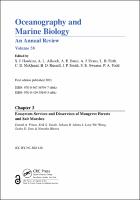Chapter 3 Ecosystem Services and Disservices of Mangrove Forests and Salt Marshes
Proposal review
Author(s)
Friess, Daniel A.
Yando, Erik S.
Alemu, Jahson B.
Wong, Lynn-Wei
Soto, Sasha D.
Bhatia, Natasha
Language
English[eng]Abstract
Coastal wetlands such as mangrove forests and saltmarshes provide a range of important benefits to people, broadly defined as ecosystem services. These include provisioning services such as fuelwood and food, regulating services such as carbon sequestration and wave attenuation, and various tangible and intangible cultural services. However, strong negative perceptions of coastal wetlands also exist, often driven by the perceived or actual ecosystem disservices that they also produce. These can include odour, a sense of danger, and their real or perceived role in vector and disease transmission (e.g., malaria). This review provides an introduction to the ecosystem services and disservices concepts, and highlights the broad range of services and disservices provided by mangrove forests and saltmarshes. Importantly, we discuss the key implications of ecosystem services and disservices for the management of these important coastal ecosystems. Ultimately, a clear binary does not exist between ecosystem services and disservices; an ecosystem service to one stakeholder can be viewed as a disservice to another, or a service can change seasonally into a disservice, and vice versa. It is not enough to only consider the beneficial ecosystem services that coastal wetlands provide: instead, we need to provide a balanced view of coastal wetlands that incorporates the complexities that exist in how humans relate to and interact with these important coastal ecosystems.
Keywords
Volume, Todd, Swearer, Smith, S, Russell, Review, P, OMBAR, Oceanography, Marine, L, I, Hawkins, Firth, Evans, Biology, Bates,B, Annual, AllcockISBN
9780367367947, 9780429351495, 9780367524722Publisher
Taylor & FrancisPublisher website
https://taylorandfrancis.com/Publication date and place
2020Imprint
CRC PressClassification
Marine biology


 Download
Download